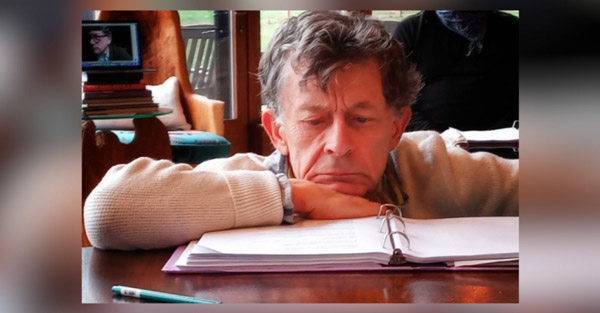By Ilene Dube, JerseyArts.com
originally published: 03/28/2024
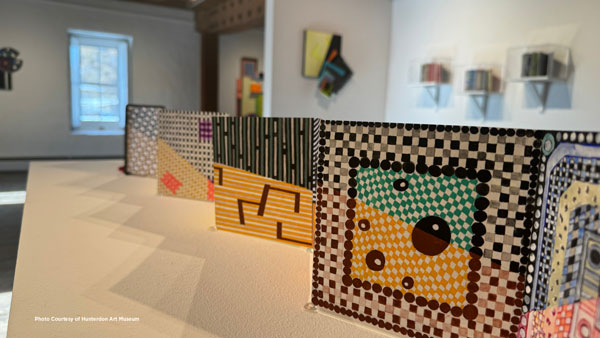
The Pattern & Decoration (P&D) movement emerged in the 1970s as an "irreverent upstart movement," to borrow the words of New York Times art critic Roberta Smith. It offered an alternative "to the general manliness of modernism," and elevated women's work. It looked to decorative traditions across the world, to surfaces like textiles, to wallpaper, manuscript illuminations, mosaics, glassware, embroideries, and architectural flourishes, writes Tess Thakara at Artsy.net.
P&D’s excesses were a response to the minimalism that prevailed in the art world, and the unofficial P&D battle cry was “more is more,” said Anna Katz in a catalog essay for the survey “With Pleasure: Pattern and Decoration in American Art 1972–1985” that traveled to several museums in 2021.
Among the P&D founders, which included artists Miriam Schapiro and Joyce Kozloff, was Cynthia Carlson. Cynthia Carlson: Serious Play is on view at the Hunterdon Art Museum (HAM) through April 28.
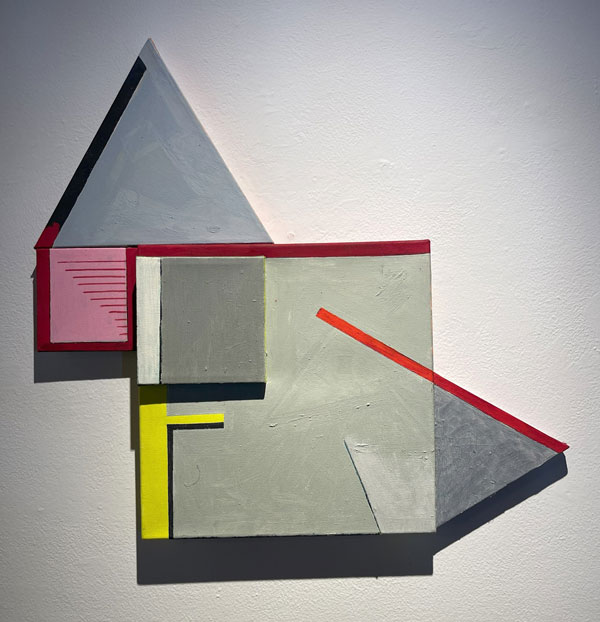
Over the Top, Cynthia Carlson. Courtesy of Hunterdon Art Museum.
In an opening reception, curator Mary Birmingham referred to Carlson as a legend. Not only was she a founder of the P&D movement “but she never stopped creating and changing and trying new things, reinventing her style, and techniques.
“Throughout her long career is the spirit of experimentation, buoyed by unflagging optimism,” continued the independent curator, a one-time director of HAM. “I wanted to bring her work here because it is playful and full of joy.”
Born in Chicago and earning a bachelor’s degree at the Art Institute of Chicago, Carlson moved to New York in 1965 to earn an MFA from Pratt. Nearly 60 years later she still lives in the city.
“I am compulsive and like to keep busy,” says the 82-year-old, who retired from a teaching career at Queens College 15 years ago. “That’s why I like to live in New York. You can never relax. Ever.” With spikey silver hair and round red glasses, she came to HAM wearing a black-and-white striped fitted dress and a scarf with dots and stripes, making it no secret she still loves patterns.
“I try to solve problems by looking at how other artists do it,” she says, citing Edouard Vuillard and Pierre Bonnard as two of her favorites (she also names Matisse as an influence – three masters of pattern). “You have no idea of what’s the background and what is the foreground,” she says of Vuillard and Bonnard. “I like to mess up the foreground and background.”
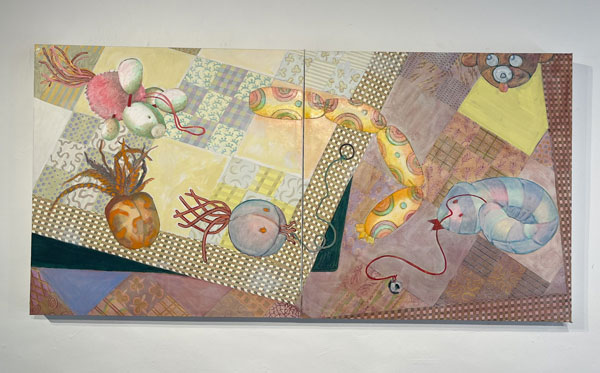
Employ Their Surplus, Cynthia Carlson. Courtesy of Hunterdon Art Museum.
Early in her career, she made “interior landscapes,” and was included in the 1971 groundbreaking exhibition Twenty Six Contemporary Women Artists at the Aldrich Contemporary Art Museum in Redding Connecticut. It was considered to have been the first feminist exhibition in the U.S., and it marked the debut of several unknown artists who would later become stars, among them Mary Heilmann, Howardena Pindell, and Adrian Piper. The exhibition was reprised in 2022 as 52 Artists: A Feminist Milestone. In an interview for the second exhibition at the Aldrich, Carlson recounted how she’d changed stylistically over the years. Confronted by dadaism and minimalism, she felt the need to rebel to find her own way, “to go in the opposite direction of whatever was prevailing And so rather than pare things down I was jamming them in.”
Her works at HAM are constructions, built from an assortment of shapes and sizes. These came about as a result of her being penurious about discarding art materials. She had completed a body of expressionist portraits that, she says, she liked very much, but for various reasons was uncomfortable exhibiting them. So she cut them up and put together the pieces in completely new ways, with triangles and arrows and open windows in the middle. The panels are painted in her signature palette and patterns.
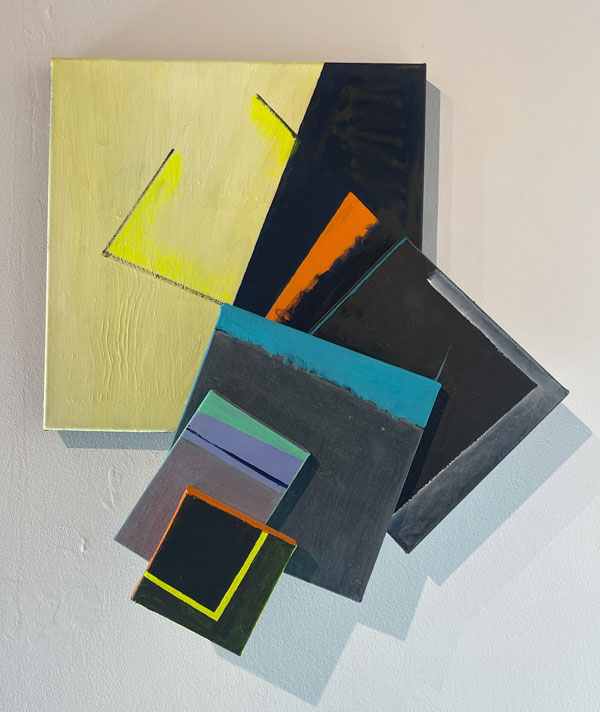
Daring Efforts, Cynthia Carlson. Courtesy of Hunterdon Art Museum.
The assemblages are a nod to Mondrian’s geometry and his palette of primary colors, writes Marcia E. Vetrocq in “Cynthia Carlson: 60 Years,” the artist’s comprehensive monograph.
Curator Mary Birmingham first met Carlson in 2022, “but I immediately felt like I had known her much longer. While I was aware of her important contributions to the Pattern and Decoration movement of the 1970s, I was blown away when I saw these shaped paintings in her studio. They had such a lively energy! I found them to be innovative and thoroughly captivating. I loved her mastery of color and composition in work that still somehow felt experimental and fresh.
“They have a certain lightheartedness and joy, which they convey to the viewer,” Birmingham continues. “I love that Cynthia, despite her stature in the art world, makes work that never takes itself too seriously. Her sense of playfulness, evident in the work, makes it easy for viewers to love. Being very familiar with the galleries at the Hunterdon, I also knew that Cynthia's work would work very well in the space.”
Carlson, who was previously unfamiliar with HAM, found the proportion of the space to be just right for the assemblages. “It’s a beautiful museum in a community that supports the arts,” she said. Even though a significant amount of snow was forecast for the opening reception, Carlson was delighted to see how many attended.
In addition, on view are a series of artist books Carlson made, initially, while awaiting paint to dry on other projects. She gave herself assignments for filling the books, such as using one color or limiting herself to straight lines. Ultimately this private endeavor took on a life of its own, the books of pattern becoming works in themselves. An accordion book that explodes with pattern and color is spread out on a stand in the center of the gallery, perhaps the highlight of the exhibition. It makes one wonder: Are there an infinite number of patterns? Are there always new ones to develop?
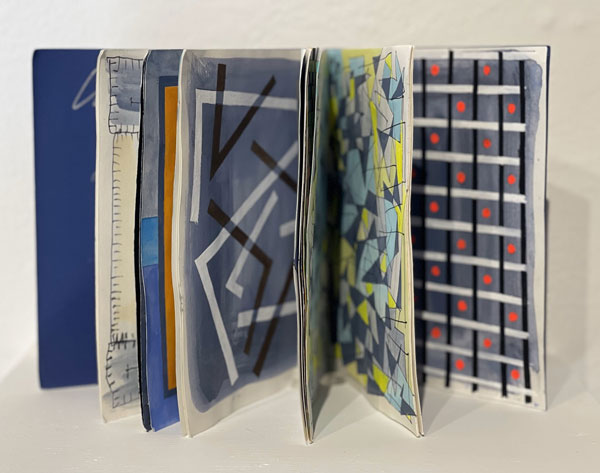
Slowing it Down, Cynthia Carlson. Courtesy of Hunterdon Art Museum.
“People talk about artists breaking boundaries,” Carlson continues. “I don’t think any of us are breaking boundaries. It’s all been done before. You can start with a grid, but the grid has been around for thousands of years.” If an artist uses the grid for structure, she says, “the only way to make something new is to own it in a way that makes it more interesting.”
Starting with “accepting a square or rectangle as the starting point… It's a logical progression from there, particularly with repetition as a method.”
Where do her ideas come from? She says she’s not really sure. “I let the paint speak to me. It’s like playing.” But she also makes clear that it’s a job.
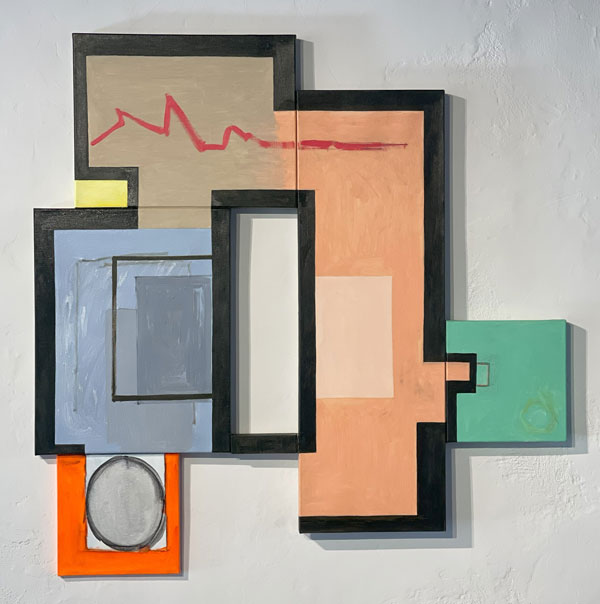
Frames and Windows, Cynthia Carlson. Courtesy of Hunterdon Art Museum.
“My work makes people think I’m in my studio having a good time,” Carlson says. “I used to tell my students, ’Don’t forget the work part.’ If you don’t have discipline you’re not going to be an artist. It’s not always fun filling in all those little squares.”
One way she separated work from play was by having a separate residence in upstate New York, where she and her husband would spend half the year. “I had built a beautiful studio there and was a good gardener – we put in a lot of trees.” But the maintenance of two homes started to become a challenge and so they sold the property.
Carlson has fairly strong ideas which she expresses gently. For example, she is adamant about museum labels that tell you what you’re looking at. Each viewer should find their own meaning, she believes. And, at the conclusion of our interview, she said, “I have a small request. In current art speak, people refer to an artist’s practice. I hate that. Dentists have a practice, doctors have a practice, but what artists do is not a practice. That term was used in an essay in my book and I took it out.”
Hunterdon Art Museum, Clinton, NJ | Through April 28, 2024
About the author: Driven by her love of the arts, and how it can make us better human beings, Ilene Dube has written for JerseyArts, Hyperallergic, WHYY Philadelphia, Sculpture Magazine, Princeton Magazine, U.S. 1, Huffington Post, the Princeton Packet, and many others. She has produced short documentaries on the arts of central New Jersey, as well as segments for State of the Arts, and has curated exhibitions at the Trenton City Museum at Ellarslie and Morven Museum in Princeton, among others. Her own artwork has garnered awards in regional exhibitions and her short stories have appeared in dozens of literary journals. A life-long practitioner of plant-based eating, she can be found stocking up on fresh veggies at the West Windsor Farmers Market.
Content provided by
Discover Jersey Arts, a project of the ArtPride New Jersey Foundation and New Jersey State Council on the Arts.
FEATURED EVENTS
Narrow results by date, categories, or region of New Jersey.
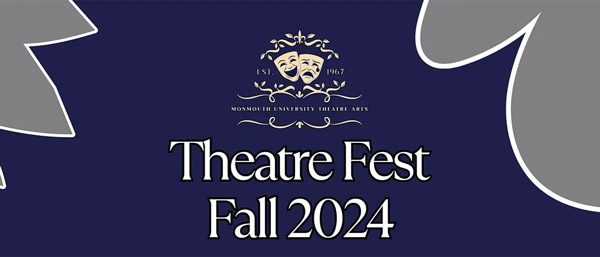
Theatre Fest Fall 2024 – Spark Sessions: A Night of Original Works by MU Players
Thursday, November 21, 2024 @ 8:00pm
Monmouth University - Lauren K. Woods Theatre
370 Cedar Avenue, West Long Branch, NJ 07764
category: theatre
View event page for full information
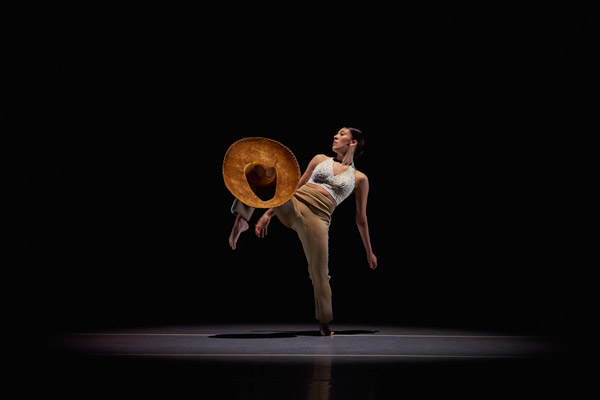
Fall Dance Plus
Thursday, November 21, 2024 @ 7:30pm
New Brunswick Performing Arts Center (NBPAC)
11 Livingston Avenue, New Brunswick, NJ 08901
category: dance
View event page for full information

Elf The Musical
Thursday, November 21, 2024 @ 7:00pm
Count Basie Center for the Arts
99 Monmouth Street, Red Bank, NJ 07701
category: theatre
View event page for full information

World Cinema Series - "Court"
Thursday, November 21, 2024 @ 6:00pm
Monmouth University - Pollak Theatre
400 Cedar Avenue, West Long Branch, NJ 07764
category: film
View event page for full information

Trombone Shorty & Orleans Avenue
Thursday, November 21, 2024 @ 7:30pm
State Theatre New Jersey
15 Livingston Avenue, New Brunswick, NJ 08901
category: music
View event page for full information

Randall Goosby Returns: Renaissance Quartet
Thursday, November 21, 2024 @ 7:30pm
McCarter Theatre Center (Matthews Theater)
91 University Place, Princeton, NJ 08540
category: music
View event page for full information

Marshall Crenshaw - Up Close & Personal
Thursday, November 21, 2024 @ 7:30pm
Lizzie Rose Music Room
217 E. Main Street, Tuckerton, NJ 08087
category: music
View event page for full information
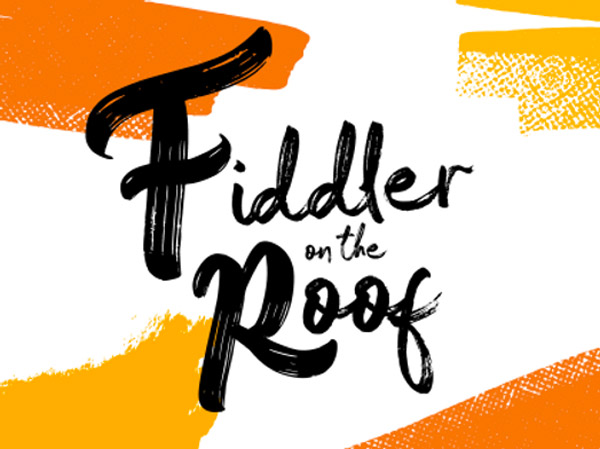
Fiddler On The Roof
Thursday, November 21, 2024 @ 11:00am
Axelrod Performing Arts Center
100 Grant Avenue, Deal Park, NJ 07723
category: theatre
View event page for full information

Steve Hofstetter
Thursday, November 21, 2024 @ 8:00pm
Avenel Performing Arts Center
150 Avenel Street, Avenel, NJ 07001
category: comedy
View event page for full information
More events
Event Listings are available for $10 and included with our banner ad packages
EVENT PREVIEWS

Renaissance Quartet Brings Bold Innovation and Classical Mastery to McCarter Theatre on Thursday
(PRINCETON, NJ) -- Prepare to be captivated by the Renaissance Quartet, featuring violinists Randall Goosby and Jeremiah Blacklow, violist Jameel Martin, and cellist Daniel Hass. Graduates of the Juilliard School and mentored by the legendary Itzhak Perlman, the Quartet brings a unique blend of classical mastery and innovative flair to McCarter Theatre on Thursday, November 21, 2024 at 7:30pm. Known for reimagining chamber music traditions, this New York based ensemble combines technical excellence with a bold, forward-thinking approach that appeals to a diverse audience.
UPCOMING EVENTS
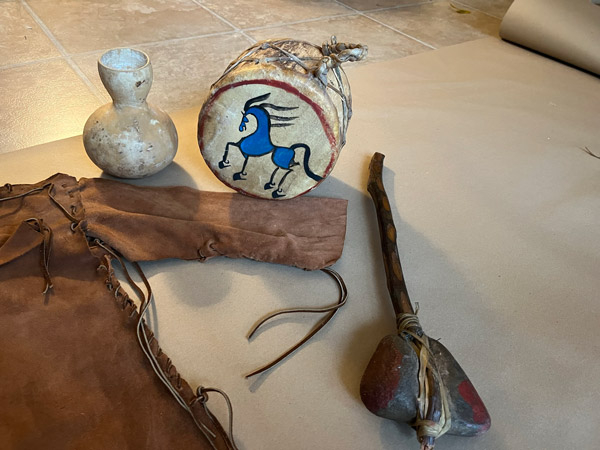
South Jersey's Indigenous Communities Celebrated in New A.C. Arts Garage Exhibit
(ATLANTIC CITY, NJ) -- A new exhibit at the Noyes Arts Garage of Stockton University will celebrate two southern New Jersey tribal communities through the display of historical documents, traditional artifacts and contemporary art. "Still Here: The Nanticoke Lenni-Lenape and Powhatan-Renape Nations of Southern New Jersey" opens October 9 and runs until January 5, 2025.



















